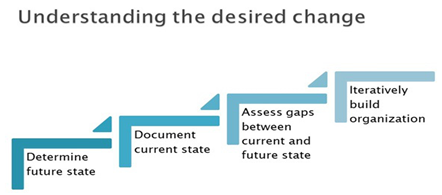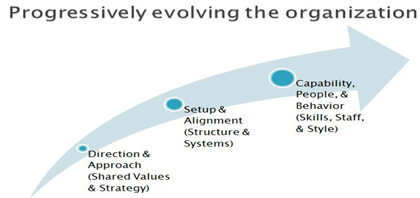McKinsey 7S Framework
What is the McKinsey 7-S Framework
The McKinsey 7-S Model is a change framework based on a company’s organizational design. It aims to depict how change leaders can effectively manage organizational change by strategizing around the interactions of seven key elements: structure, strategy, system, shared values, skill, style, and staff.
The model highlights that there exists a domino effect when any one element is transformed to restore effective balance. The central placement of shared values emphasizes that a strong change culture impacts all the other elements to drive change.[1]
These 7 factors are used by management to identify where a company excels and where it needs more work, in terms of creating an optimal and efficient workforce. It is also used to evaluate performance following a merger or other restructuring to identify areas that need improvement.
Developed in the early 1980s by Tom Peters and Robert Waterman of McKinsey & Company, is a management model (7S Framework), the basic premise of which is that there are seven internal aspects of an organization that need to be aligned for it to be successful.
The 7S Model can be used in a wide variety of situations where an alignment perspective is useful, for example, to help you:
- Improve the performance of a company.
- Examine the likely effects of future changes within a company.
- Align departments and processes during a merger or acquisition.
- Determine how best to implement a proposed strategy. [2]
History of the 7-S Fraamework
In 1977, McKinsey director Ron Daniel launched two projects. The first and major one, the Business Strategy project, was allocated to top consultants at McKinsey's New York City headquarters and was given significant resources. It was headed by Frederick Gluck, and despite the promise, the project could not manage to effectively implement the new strategies. The second project was related to the problem of implementation: organizational effectiveness. This project was headed by Cleveland-based James Bennet.
Peters states that directly after graduating with a Ph.D. from Stanford and returning to McKinsey, Daniel handed him a "fascinating assignment." Motivated by the new ideas coming from Bruce Henderson's Boston Consulting Group, Peters "was asked [by Daniel] to look at 'organization effectiveness' and 'implementation issues' in an inconsequential offshoot project nested in McKinsey's rather offbeat San Francisco office." While Daniel's first project was focused on Business Strategy, this second project was concerned with "Organization" which Peters defined as involving "the structure-and-people side.". The "Organization" project was seen by Peters to be less important, according to Peters in a Fast Company interview.
Despite being described as "marginal," the project "had an infinite travel budget that allowed [Peters] to fly first-class and stay at top-notch hotels, and a license from McKinsey to talk to as many cool people as he could all around the United States and the world. "Peters admits that "There was no carefully designed work plan. There was no theory that I was out to prove. I went out and talked to genuinely smart, remarkably interesting, first-rate people." In addition to Karl Weick and Einar Thorsrud, Peters notes that Douglas McGregor's theory of motivation, known as Theory X and Theory Y, was directly influential on the direction of the project.
In a 1978 article, "Symbols, Patterns and Settings," Peters argued that "shifting organizational structure" and "inventing new processes" - structure and system, respectively - were only two tools of organizational change. Peters then outlined eight "mundane" tools that every manager has at their fingertips. He described this article as a "tentative presentation" and "the first public expression of these ideas."
In 1979, McKinsey's Munich office requested Peters to present his findings to Siemens. That provided the spur for Peters to create a 700-slide two-day presentation. Word of the meeting reached the US and Peters was invited to present also to PepsiCo. However, unlike the hyper-organized Siemens, the PepsiCo management required a tighter format than 700 slides, so Tom Peters consolidated the presentation into eight themes. Each of these eight would form a chapter of In Search of Excellence.
In 1980, Waterman joined Peters, and, along with Waterman's friends Tony Athos and Richard Pascale - both academics - came together at a two-day retreat in San Francisco to develop what would become known as the 7S Framework, the same framework that would organize In Search of Excellence. In June 1980, Peters published an op-ed in the Manager's Journal section of the Wall Street Journal titled "The Planning Fetish." In this article, he "stressed the importance of execution and dismissed the whole idea of strategy." As strategy was McKinsey's main operation at the time, this was seen as a "frontal assault" on the company, leading Mike Bulkin, the head of the New York office, to demand that Daniel fire Peters.
The primary "innovative" theme that undergirded what would become the well-known book In Search of Excellence book was that "structure is not an organization." This also happened to be the title of a 1980 journal article authored by Bob Waterman, Tom Peters, and Julien Phillips in which they argue that the "picture of the thing is not the thing... An organizational structure is not an organization." This article also introduced what would become the McKinsey 7S Framework.
In Search of Excellence
The work of Peters, Waterman, Athos, and Pascale leading up to the widely successful In Search of Excellence, not only elaborated the eight themes that would form each chapter, but also the 7 S's frame the different ways in which the firms profiled in the book were "excellent."
The Art of Japanese Management
Athos and Pascale, although not named as co-authors of the 1982 publication of In Search of Excellence, published their own study in a 1981 book titled The Art of Japanese Management. This book used the 7S Framework to compare the Japanese firm Matsushita with the American company ITT. Just as Peters emphasized throughout his writing, the important distinction between American and Japanese management was not the so-called "hard" technical aspects of the organization, but rather the "soft" cultural aspects.[3]
Elements of The 7S Model
The basic premise of the model is that there are seven internal aspects of an organization that need to be aligned if it is to be successful The Elements are split into two groups - Hard and Soft
- Hard Elements
- Strategy - Purpose of the business and the way the organization seeks to enhance its competitive advantage.
- Structure - Division of activities; integration and coordination mechanisms.
- Systems - Formal procedures for measurement, reward, and resource allocation.
- Soft Elements
- Shared Values
- Skills - The organization's core competencies and distinctive capabilities.
- Staff - Organization's human resources, demographic, educational, and attitudinal characteristics.
- Style - Typical behavior patterns of key groups, such as managers, and other professionals.
There is no hierarchy in terms of the importance of these interrelated elements suggesting that any significant progress with one would not be possible without working on the others.

Source: The Organizational Strategist
Applying McKinsey 7S Model Assessments
With the planned change, the destination or future state should be understood first. This knowledge gives perspective. Having a future state vision allows one to gauge progress, set targets, and milestones to achieve. Once the future state is known, the current state can be documented to show a comparison. This makes it clear what can be leveraged, where the current strengths are, and where there are areas to build or holes to fill. The gap analysis leads to steps to build upon.[4]
In order to most effectively change an organization, the foundational characteristics (Shared Values) and broad-ranging direction (Strategy) should be addressed first. Following that, the internal coordination (Structure) and setup (System) should be determined to align with the direction. Lastly, the more people-centric areas fulfill an organization’s goals and objectives. That is done via updates to its capability (Skills), individual placement (Staff), and the manners in that people interact and work (Style).
The McKinsey 7S Model is helpful in delivering a comprehensive organizational analysis. Using that information can lead to a new vision, through internal operation updates, and down to individual abilities and placement. Mapping out the change in its entirety is very helpful in its planning. The successful execution and management of that change then requires a comprehensive, dedicated, business impact-focused, and sustained effort.
Advantages and Disadvantages of the McKinsey 7S Framework [5]
Advantages of the Model
It enables different parts of a company to act in a coherent and “synced” manner.
It allows for the effective tracking of the impact of the changes in key elements.
It is considered a longstanding theory, with numerous organizations adopting the model over time.
Disadvantages of the Model
It is considered a long-term model.
With the changing nature of businesses, it remains to be seen how the model will adapt.
It seems to rely on internal factors and processes and may be disadvantageous in situations where external circumstances influence an organization.
See Also
References
Further Reading
Enduring Ideas: The 7-S Framework



